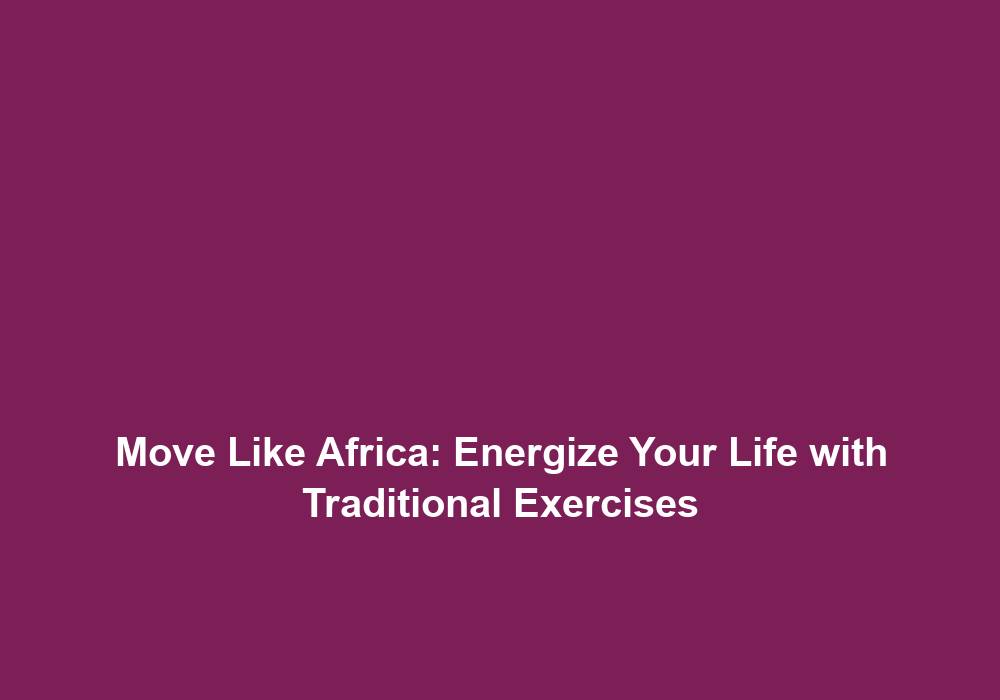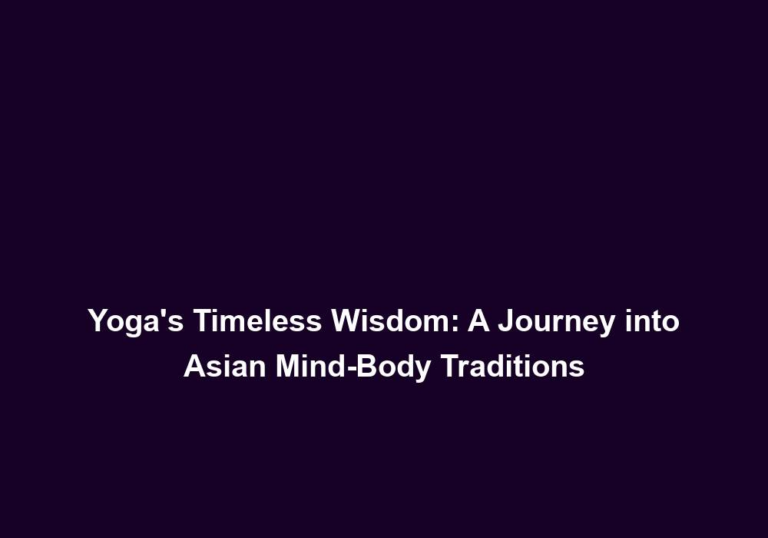Move Like Africa: Energize Your Life with Traditional Exercises
In the bustling continent of Africa, rich in diverse cultures and traditions, physical activity is deeply intertwined with daily life. Traditional exercises have been passed down through generations, not only as a means of staying fit but also as a way to connect with the land, community, and spirit. These unique fitness practices offer a refreshing alternative to modern workout routines, infusing vitality and a sense of adventure into your fitness journey. Let’s delve into some fascinating traditional exercises that will invigorate your body, mind, and soul.
1. Maasai Jumping (Adumu)
Adumu, also known as the Maasai Jumping, is a traditional exercise performed by the Maasai people of East Africa. This awe-inspiring activity showcases the agility, strength, and endurance of the Maasai warriors. It involves a series of vertical jumps, where participants leap into the air while keeping their bodies straight and their feet together. As the intensity increases, the participants compete to jump higher and longer.
The Maasai Jumping not only serves as a form of exercise but also as a way to celebrate and showcase the strength and vitality of the community. By incorporating this dynamic movement into your fitness routine, you can enhance your cardiovascular endurance, leg strength, and overall explosiveness.
- The Maasai Jumping is a high-intensity exercise that engages multiple muscle groups, including the legs, core, and upper body.
- It improves cardiovascular fitness by elevating the heart rate and promoting efficient oxygen circulation throughout the body.
- Regular practice of Maasai Jumping can enhance coordination, balance, and agility, as participants need to maintain proper form and control during each jump.
Furthermore, the Maasai Jumping is deeply rooted in Maasai culture and tradition. It serves as a symbol of bravery and is often performed during important ceremonies and rites of passage. By embracing this traditional exercise, you not only improve your physical fitness but also gain a deeper appreciation for the cultural heritage of the Maasai people.
2. Capoeira
Originating from Brazil and influenced by African cultural practices, Capoeira is a vibrant martial art disguised as a dance. It combines elements of acrobatics, music, and rhythmic movements. Capoeira builds strength, flexibility, and coordination, while also emphasizing self-expression and camaraderie.
During a Capoeira session, participants engage in a playful game where they exchange acrobatic movements, kicks, and sweeps while maintaining a rhythmic flow. The integration of music, typically played by a berimbau (a traditional musical instrument), adds to the captivating atmosphere and energizes the participants. Capoeira not only enhances physical fitness but also cultivates a deep sense of community and self-confidence.
- Capoeira is a full-body workout that engages the muscles of the arms, legs, core, and back, promoting overall strength and toning.
- The acrobatic movements in Capoeira improve flexibility, balance, and body control, as participants learn to execute flips, cartwheels, and handstands.
- The rhythmic nature of Capoeira enhances coordination and timing, as participants must synchronize their movements with the music and their partners.
Moreover, Capoeira is deeply rooted in the history of African slaves in Brazil. It served as a form of self-defense and cultural expression during a time of oppression. By practicing Capoeira, you not only improve your fitness but also honor the resilience and creativity of those who developed this art form.
3. Kalari Payattu
Hailing from the southern Indian state of Kerala, Kalari Payattu is an ancient martial art form that combines combat techniques, physical conditioning, and spiritual practices. This holistic discipline encompasses strikes, kicks, grappling, weaponry, and intricate body movements.
Kalari Payattu practitioners go through rigorous training to develop strength, flexibility, and agility. The art form also emphasizes the synchronization of mind and body, promoting mental clarity and discipline. By incorporating elements of Kalari Payattu into your fitness routine, you can enhance your combat skills, improve concentration, and awaken your inner warrior spirit.
- Kalari Payattu training involves a wide range of movements, including punches, kicks, jumps, and rolls, which provide a comprehensive workout for the entire body.
- The precise and controlled execution of techniques in Kalari Payattu improves coordination, body awareness, and reaction time.
- The mental focus required in Kalari Payattu enhances mindfulness and concentration, as practitioners must stay fully present and attuned to their movements and surroundings.
Additionally, Kalari Payattu is deeply rooted in Indian mythology and philosophy. It is considered a path to self-discovery and self-realization. By practicing this traditional martial art, you not only improve your physical fitness but also embark on a journey of self-exploration and inner growth.
4. Dabkeh
Dabkeh, a traditional folk dance hailing from the Levant region, is a lively and energetic group dance performed at weddings, cultural events, and celebrations. This rhythmic dance involves synchronized footwork, energetic jumping, and intricate movements that engage the entire body.
Participating in Dabkeh can be a joyous and exhilarating way to improve cardiovascular endurance, coordination, and leg strength. The communal aspect of this dance fosters a sense of togetherness and builds social connections, making it an ideal exercise for those seeking a lively and uplifting group activity.
- Dabkeh is a high-energy dance that elevates the heart rate, promoting cardiovascular fitness and calorie burn.
- The synchronized footwork and jumps in Dabkeh improve agility, coordination, and lower body strength.
- The repetitive nature of Dabkeh movements enhances muscular endurance, as participants maintain the rhythm and energy throughout the dance.
Furthermore, Dabkeh is deeply ingrained in the cultural fabric of the Levant region. It serves as a form of celebration and expression of joy. By embracing this traditional dance, you not only improve your physical fitness but also immerse yourself in the vibrant and rich traditions of the Levant.
5. Nguni Stick Fighting
Nguni Stick Fighting, also known as Donga, is a traditional Zulu martial art form that dates back centuries. This discipline involves combat with long sticks, emphasizing agility, reflexes, and strategic thinking. It is both a physical exercise and a way to preserve cultural heritage and warrior traditions.
Participating in Nguni Stick Fighting can enhance your coordination, upper body strength, and concentration. It also provides an opportunity to immerse yourself in the rich cultural history of the Zulu people. By embracing this traditional exercise, you can strengthen both your body and your connection to African traditions.
- Nguni Stick Fighting is a dynamic and fast-paced martial art that improves cardiovascular fitness and stamina.
- The techniques and movements in Nguni Stick Fighting engage the muscles of the arms, shoulders, and core, promoting upper body strength and endurance.
- The strategic nature of Nguni Stick Fighting enhances mental agility, as participants must anticipate and react to their opponent’s moves.
Moreover, Nguni Stick Fighting holds great cultural significance and is considered a rite of passage for young Zulu warriors. By practicing this traditional martial art, you not only improve your physical fitness but also honor the bravery and heritage of the Zulu people.
Conclusion
Rediscovering traditional exercises from Africa can infuse your fitness routine with a sense of adventure, cultural richness, and physical vitality. Whether it’s the high jumps of Maasai warriors, the rhythmic movements of Capoeira, the disciplined practices of Kalari Payattu, the energetic dances of Dabkeh, or the strategic combat of Nguni Stick Fighting, these traditional exercises offer a unique and holistic approach to fitness.
Immerse yourself in the spirit of Africa, connect with its diverse cultures, and energize your life by incorporating these traditional exercises into your fitness journey. Let the vibrant rhythms, rich history, and physical prowess of Africa guide you towards a path of greater health, strength, and well-being.







